Over the last ten years, weather patterns in the Pacific Northwest have become increasingly unpredictable. Extreme temperatures are now more common in both the winter and summer seasons, while floods are larger and more frequent year round. As the climate continues to change, experts anticipate a much stormier Pacific Northwest. They expect the number of extreme weather days to increase by a quarter by the end of the century. During the COVID-19 pandemic, Americans became more aware of climate change and its consequences. Wildfires, floods, droughts, heat waves and other disasters along the West Coast exposed our many vulnerabilities. At the same time, Americans became more appreciative of nature and prioritized time spent outdoors. Because of this, many West Coast residents have begun rethinking how we design, build and live in our homes. On the heels of the pandemic, residents want spaces that are more resilient and more adaptable. According to recent reports, homeowners have already started transforming their homes to meet these new expectations. Despite an economic recession, 2020 saw the greatest number of home improvement projects in US history. Market watchers expect 2021 to beat this new record, with homeowners focusing primarily on outdoor spaces. Writing for Forbes in March, Pamela N Danziger declared 2021 the “‘Year of the Yard.’” According to Danziger and a recent survey, “90% of Americans agree that their outdoor living space is more valuable than ever before.” Almost 80% of respondents to this survey “upgraded their outdoor living areas in 2020.” However, a surprising “88% of Americans are [still] dissatisfied with their outdoor spaces.” In the Pacific Northwest, homeowners are searching for ways to enjoy an indoor-outdoor lifestyle all year long. To transform your own outdoor space, follow below for eight ways to create a year-round outdoor space in the Pacific Northwest.
Eight Tips for Creating a Year-Round Outdoor Space in the Pacific Northwest
As we transition into Fall and the rainy season begins, entertaining guests in your backyard or on your patio becomes less appealing. However, there are a number of ways to make outdoor entertaining more feasible during the chilly, rainy months. Host al fresco dinner parties and weekend brunches all winter long with our tips for creating a year-round outdoor space in the Pacific Northwest.
#1 Start with Hardscaping in Your Outdoor Space
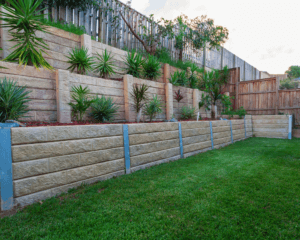 Before shopping for patio furniture, make sure to hardscape your backyard. For those unfamiliar with the term, “hardscape” refers to immovable structures like retaining walls, paths, decks and pergolas. While landscaping refers to plants, trees and other living elements of a garden, hardscaping refers to all permanent, non-living elements. Hard-scaping is the essential first step in creating a functional outdoor space because it defines the space and protects that space from the elements. For example, retaining walls protect yards from floods and landslides while raised decks keep feet and furniture dry. Because many hardscape projects must be built to code, homeowners should consider hiring a design-build team to engineer and implement their home’s hardscaping. Working with a designer on your yard’s hardscaping ensures climate-resilient building materials are used and structural integrity is maintained. Click here to book a call and someone from the team at VanderBeken Remodel will give you a call when it’s most convenient for you.
Before shopping for patio furniture, make sure to hardscape your backyard. For those unfamiliar with the term, “hardscape” refers to immovable structures like retaining walls, paths, decks and pergolas. While landscaping refers to plants, trees and other living elements of a garden, hardscaping refers to all permanent, non-living elements. Hard-scaping is the essential first step in creating a functional outdoor space because it defines the space and protects that space from the elements. For example, retaining walls protect yards from floods and landslides while raised decks keep feet and furniture dry. Because many hardscape projects must be built to code, homeowners should consider hiring a design-build team to engineer and implement their home’s hardscaping. Working with a designer on your yard’s hardscaping ensures climate-resilient building materials are used and structural integrity is maintained. Click here to book a call and someone from the team at VanderBeken Remodel will give you a call when it’s most convenient for you.
#2 Softscape with Indigenous Plants
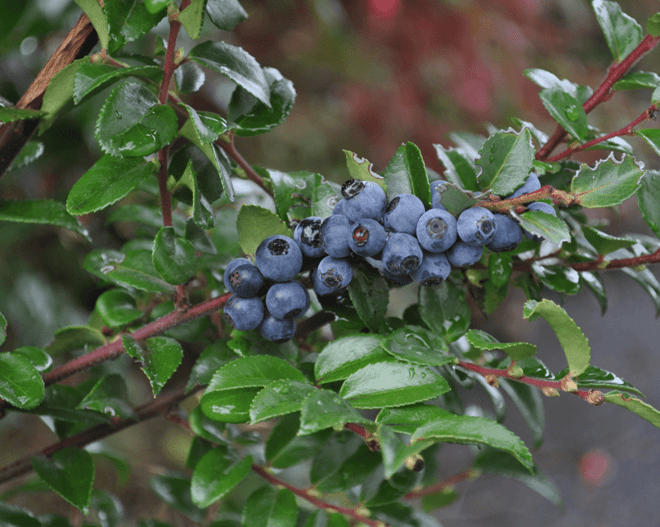 Next, homeowners should move on to softscaping or landscaping their yard. Many homeowners opt either for monocultures of grass or gardens of exotic, year-round perennials. While beautiful, these plants might not actually contribute to a functional outdoor space. Instead, invasive species can eliminate native species and decimate the soil quality of a yard. This can lead to soil erosion.
Next, homeowners should move on to softscaping or landscaping their yard. Many homeowners opt either for monocultures of grass or gardens of exotic, year-round perennials. While beautiful, these plants might not actually contribute to a functional outdoor space. Instead, invasive species can eliminate native species and decimate the soil quality of a yard. This can lead to soil erosion.
By choosing indigenous plants, homeowners can mitigate these issues. Native plants of the Pacific Northwest are well-adapted to its unique terrain and climate. As such, adding indigenous species can help prevent a yard from flooding and puddles from forming. These species may also attract pollinators and other wildlife, creating a sustainable ecosystem in your backyard.
#3 Create Transitional Spaces
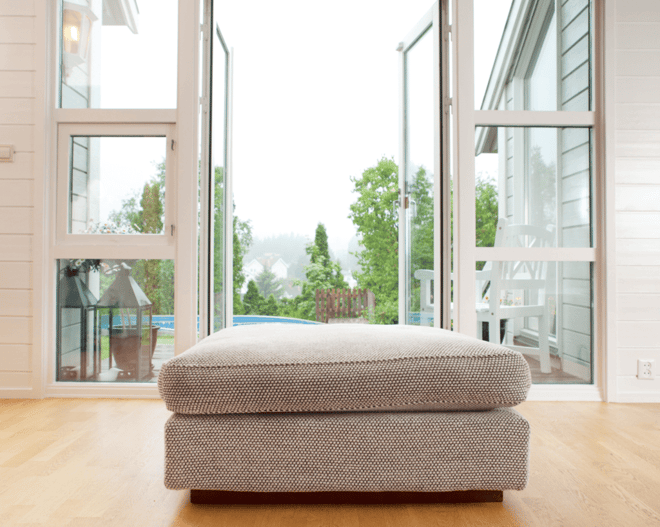 Next, homeowners should create transitional spaces with the help of a design-build firm that understands building codes and permitting requirements. Consider opening up a breezeway, building a sunroom, covering your porch or adding glass pocket doors to rooms that access your backyard.
Next, homeowners should create transitional spaces with the help of a design-build firm that understands building codes and permitting requirements. Consider opening up a breezeway, building a sunroom, covering your porch or adding glass pocket doors to rooms that access your backyard.
Easing the transition between outdoor and indoor spaces will make both the interior and exterior of your home feel larger and more inviting. Choosing flooring materials and furniture that match the interior of your home can also help ease the transition.
#4 Pick the Right Furniture
When choosing furniture for your transitional indoor-outdoor space, consider pieces with durable upholstery, sturdy frames and adaptable designs. If exposed to the elements, the wrong patio furniture will fade, crack and/or grow mold. For patio furniture that survives Pacific Northwest weather, avoid hydrophilic materials like wood and wicker. Also avoid metals that easily oxidize when exposed to moisture or are light enough to blow away on a gust of wind. Similarly, plastic furniture might discolor when exposed to the sun or crack if tossed by the wind.
Above all, The Washington Post writer Helen Carefoot recommends homeowners “buy the best-quality pieces [they] can afford.” In her article “How to choose outdoor furniture that will last,” Carefoot recommends opting for wrought iron or stainless steel pieces with “powder-coated finishes.” When picking upholstery for your patio furniture, opt for treated materials “that are protected from moisture and UV damage.” Consult with a designer for best results.
#5 Find Waterproof Finishings
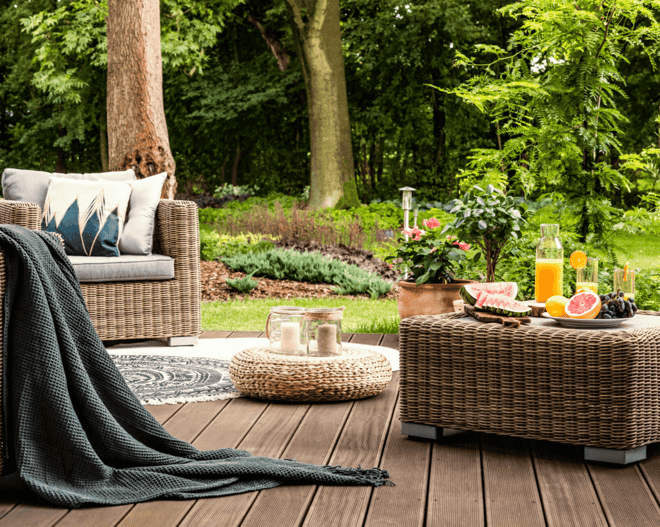 Consider adding home décor elements like area rugs, throw pillows and curtains to tie your outdoor living space together. Adding accent pillows and cozy throw blankets makes transitional outdoor living spaces feel more inviting while keeping guests warm. Hanging waterproof curtains from your pergola or covered patio not only creates an intimate space but also protects from the elements. In the winter, waterproof curtains protect from rain and wind while in the winter they protect from bugs and from the sun’s glaring rays. Best of all, writes Jessica Bennett in a recent article for Better Homes & Gardens, “outdoor curtains are a decorative element that can add personality.” For stain-repellent, moisture-resistant fabrics that stand the test of time, consult with a local designer.
Consider adding home décor elements like area rugs, throw pillows and curtains to tie your outdoor living space together. Adding accent pillows and cozy throw blankets makes transitional outdoor living spaces feel more inviting while keeping guests warm. Hanging waterproof curtains from your pergola or covered patio not only creates an intimate space but also protects from the elements. In the winter, waterproof curtains protect from rain and wind while in the winter they protect from bugs and from the sun’s glaring rays. Best of all, writes Jessica Bennett in a recent article for Better Homes & Gardens, “outdoor curtains are a decorative element that can add personality.” For stain-repellent, moisture-resistant fabrics that stand the test of time, consult with a local designer.#6 Heat the Space
Plush rugs, insulated curtains and cozy blankets certainly help. However, they might not be enough to keep you and your guests warm on chilly winter nights in the Pacific Northwest. Make your outdoor living space more habitable year-round by installing a variety of heating implements. Consider working with a designer to install heated floors on your deck or patio. Purchase heat lamps, find a dining table with a built-in fire pit or invest in an outdoor fireplace. Consult with a professional before adding heating implements to your outdoor space to ensure adequate ventilation and reduce fire risk.
#7 Invest in Outdoor Appliances
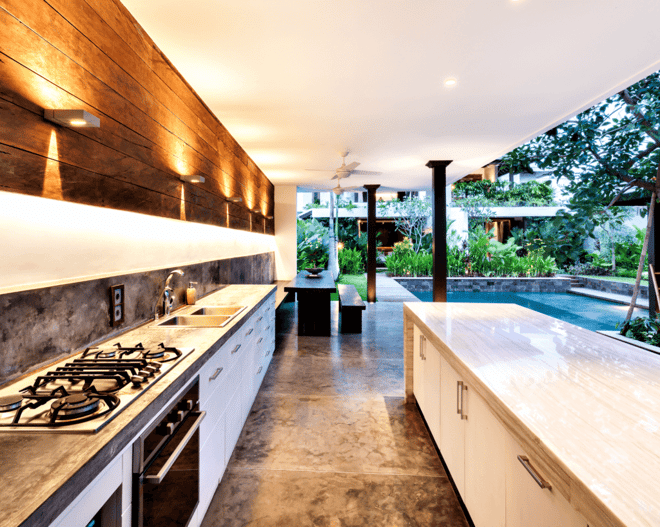 One of the best ways to make an outdoor living space truly feel like an extension of your home is to invest in appliances. One way to draw people into an outdoor space, especially in winter, is by creating some sort of activity like cooking or grilling. By making these activities possible outdoors, guests are less tempted to retreat indoors.
One of the best ways to make an outdoor living space truly feel like an extension of your home is to invest in appliances. One way to draw people into an outdoor space, especially in winter, is by creating some sort of activity like cooking or grilling. By making these activities possible outdoors, guests are less tempted to retreat indoors.
Outfitted with bars, stove tops and grills, outdoor kitchens provide the perfect place around which to gather and enjoy these activities together. Not sure where to begin? Work with a designer to determine the best way to layout your outdoor kitchen.
#8 Zone Your Outdoor Space
Keep your outdoor living space feeling fresh and fun all year-round by diversifying the layout. Instead of always gathering around the table on your covered porch, add a pair of bistro tables to your greenhouse for intimate dinners. Plant a vegetable garden near your outdoor kitchen to reinforce the idea that your yard is part of your living space. For a list of vegetables you can harvest in the Pacific Northwest through fall and winter, check out this gardening catalog from Washington University. Creating zones in your outdoor living area will prevent you and your guests from feeling stuck in a single space all winter long.
Update Your Outdoor Living Space with a Design-Build Firm
As mentioned above, numerous backyard and patio renovations require understanding of complex building codes, permitting processes and appropriate materials. When designing an outdoor living space in a climate as mercurial as that of the Pacific Northwest, working with a professional is vital. Ensure your deck stands up to high winds, your patio repels moisture and yard resists flooding by working with a design-build firm. With more than thirty years working in Snohomish County, the team at Vanderbeken Remodel understands how to tackle Pacific Northwest weather. Schedule a consultation to learn more.



